Transforming your garden into a serene haven doesn’t have to be a daunting task. Japanese gardens, known for their simplicity and timeless sophistication, offer a perfect blend of water, rocks, and plants to inspire peaceful contemplation. If you’re looking to elevate your landscaping, embracing the principles of a Japanese garden can create a tranquil retreat right in your backyard.
By incorporating essential elements and understanding the different types of Japanese gardens, you can design a space that not only enhances your home’s aesthetic but also provides a sanctuary for relaxation and reflection. Ready to bring a little zen into your landscape?
Let’s explore some Japanese garden ideas to help you achieve inner harmony and natural beauty in your outdoor space.
Essential Elements of Japanese Garden
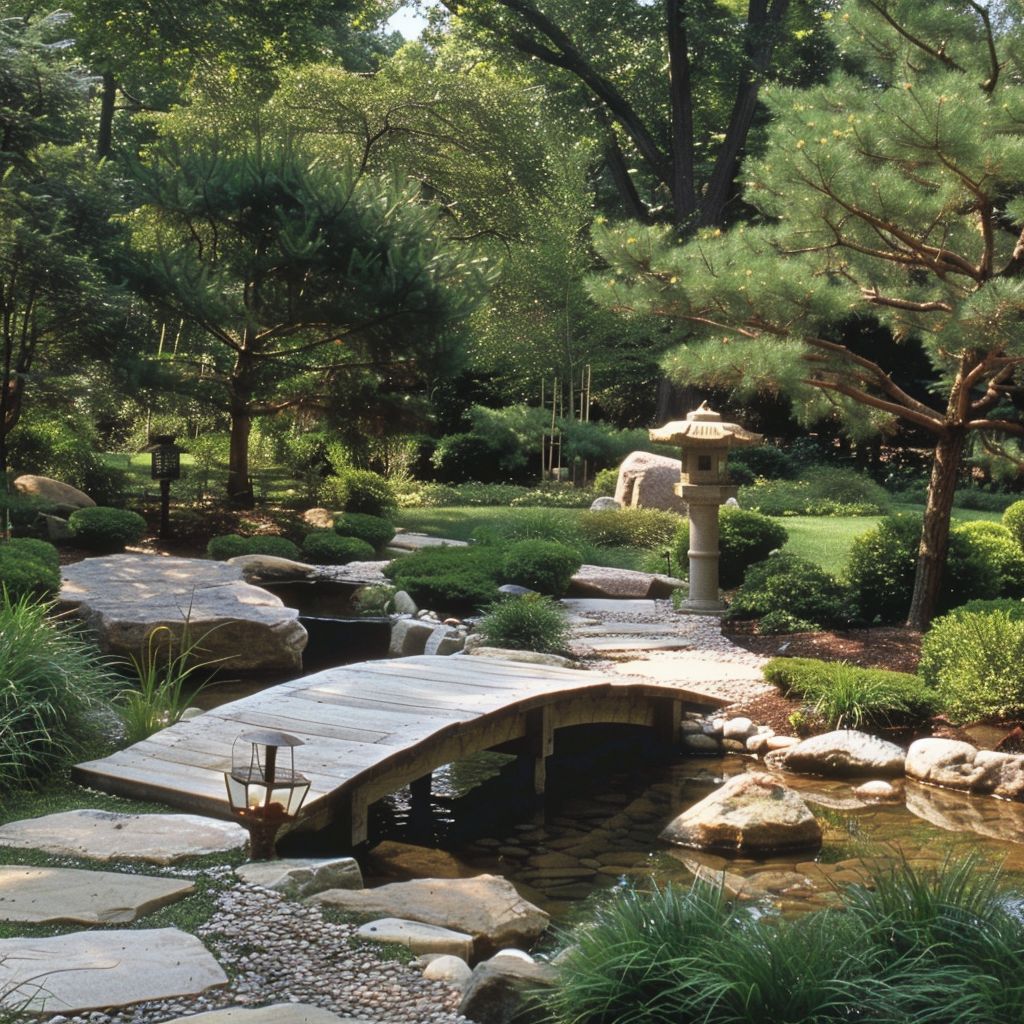
Japanese gardens blend water, rocks, and plants to create serene spaces, with water features symbolizing renewal and rocks representing permanence. Evergreens provide year-round greenery, while bamboo, moss, and flowering shrubs maintain simplicity and balance.
Paths and bridges guide movement and encourage contemplation, while lanterns and water basins add traditional touches. These elements together turn garden designs into tranquil retreats, transforming outdoor spaces into peaceful havens.
Rocks
Rocks are a fundamental component of Japanese gardens. In line with stone garden concepts, large, weathered rocks are revered and positioned prominently to represent mountains, islands, or waterfalls. The striations and shapes of these rocks are carefully considered to enhance their natural beauty and symbolic significance.
Water
Water features, such as ponds, streams, or waterfalls, are common in Japanese gardens. They represent real or mythical bodies of water and provide tranquil sounds that enhance the garden’s serene atmosphere. Koi ponds are particularly popular, adding a dynamic element with colorful fish, while water basins (tsukubai) are often used for ritual cleansing in tea gardens.
Plants
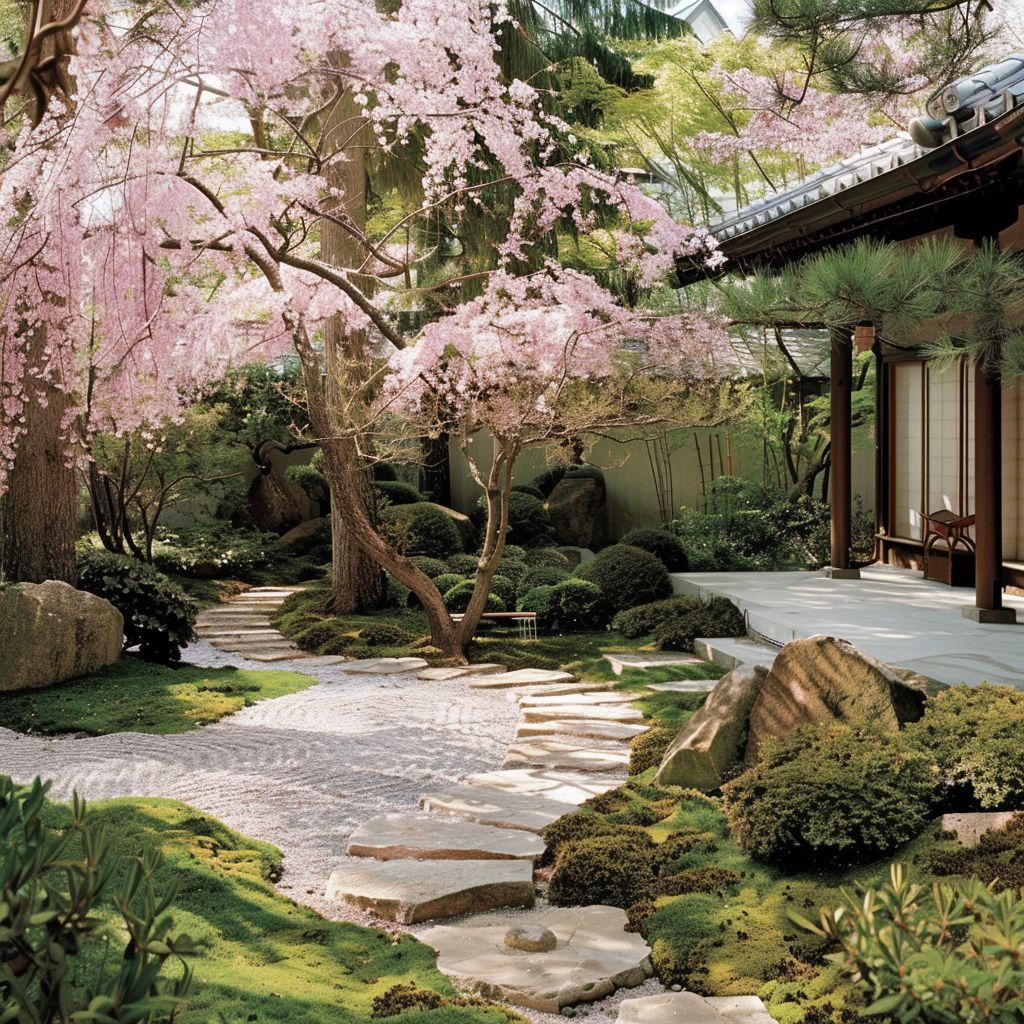
The plant palette in Japanese gardens is typically restrained, focusing on shades of green to create a sense of harmony and tranquility. Mosses, ferns, pines, and manicured shrubs are commonly used. Seasonal interest is provided by flowering trees such as cherry (sakura) or plum (ume), which add bursts of color during their blooming periods.
Ornaments
Ornaments in Japanese gardens are simple yet significant. Stone lanterns (tōrō), water basins, and bridges serve as focal points and functional elements. These ornaments are carefully placed to enhance the garden’s aesthetic and spiritual qualities.
Space and Texture
Open areas of raked gravel or sand, often seen in Zen gardens, represent water or prairie. The patterns created in the gravel are meant to evoke rippling water or waves. Varied textures of moss, stone, and sandy ground plants create visual interest and contrast, enhancing the sensory experience of the garden.
Design Principles of Japanese Garden
Japanese gardens emphasize simplicity and natural beauty, using principles like asymmetry and balance to create peaceful, uncluttered spaces. Elements such as rocks and plants represent nature’s elegance.
Incorporating water, like small ponds or streams, symbolizes renewal and adds soothing sounds. Greenery, including bamboo, moss, and evergreens, provides texture and year-round beauty, while flowering shrubs offer seasonal color.
Paths and stepping stones guide movement, with gravel or sand creating Zen-inspired areas. Lanterns and water basins illuminate the garden and add cultural depth.
Asymmetry
In Japanese garden design, symmetry is often avoided. Instead, these gardens embrace an asymmetrical balance that mimics nature’s organic flow. Paths curve gently, and elements are arranged in a way that is visually balanced but not mirrored. This creates a natural and calming aesthetic that invites exploration and contemplation.
Enclosure
Japanese gardens are often designed to be viewed from within an enclosed space, such as a pavilion or home. The idea is to frame the scenery like a living picture, enhancing the sense of seclusion and intimacy. Fences, walls, or hedges are commonly used to create this sense of enclosure, providing a private retreat from the outside world.
Borrowed Scenery

A unique principle in Japanese garden design is “borrowed scenery” (shakkei). This technique incorporates and complements distant views, such as mountains, trees, or temples, into the garden’s composition. By doing so, the garden creates a sense of depth and continuity, seamlessly blending with the surrounding landscape.
Symbolism
Symbolism is a core element in Japanese gardens. Rocks often represent mountains or islands, ponds symbolize seas or lakes, and carefully pruned trees and shrubs evoke natural scenery. Each element carries a deeper meaning, reflecting aspects of nature, spirituality, and traditional Japanese culture.
Common Types of Japanese Gardens
Explore different types of Japanese gardens to find inspiration for your own outdoor space. Each type offers a distinct style and unique elements.
Zen Garden or Dry Landscape Gardens (Karesansui)
Zen gardens, or Karesansui, use rocks, gravel, and sand to create tranquil dry landscapes. These Japanese rock gardens suggest mountains and water through carefully placed stones and raked gravel patterns. Minimalist and meditative, Karesansui gardens are iconic in Japanese culture.
Stroll Gardens (Kayushiki Teien)
Stroll gardens, known as Kayushiki Teien, invite you to walk and experience changing views. They typically feature paths, ponds, bridges, and various plants. These gardens aim to provide a sense of discovery with each step.
Tea Gardens (Chaniwa)

Tea gardens, or Chaniwa, are constructed for traditional tea ceremonies. Elements include a teahouse, stone paths, lanterns, and water basins. Each part of the garden is designed to heighten the tea-drinking experience.
Tsukiyama (Hill Gardens)
Tsukiyama, or hill gardens, are miniature landscapes that mimic natural scenery found in Japan and China. These gardens incorporate hills, ponds, trees, stones, and sometimes even small waterfalls.
Courtyard Garden (Tsuboniwa)
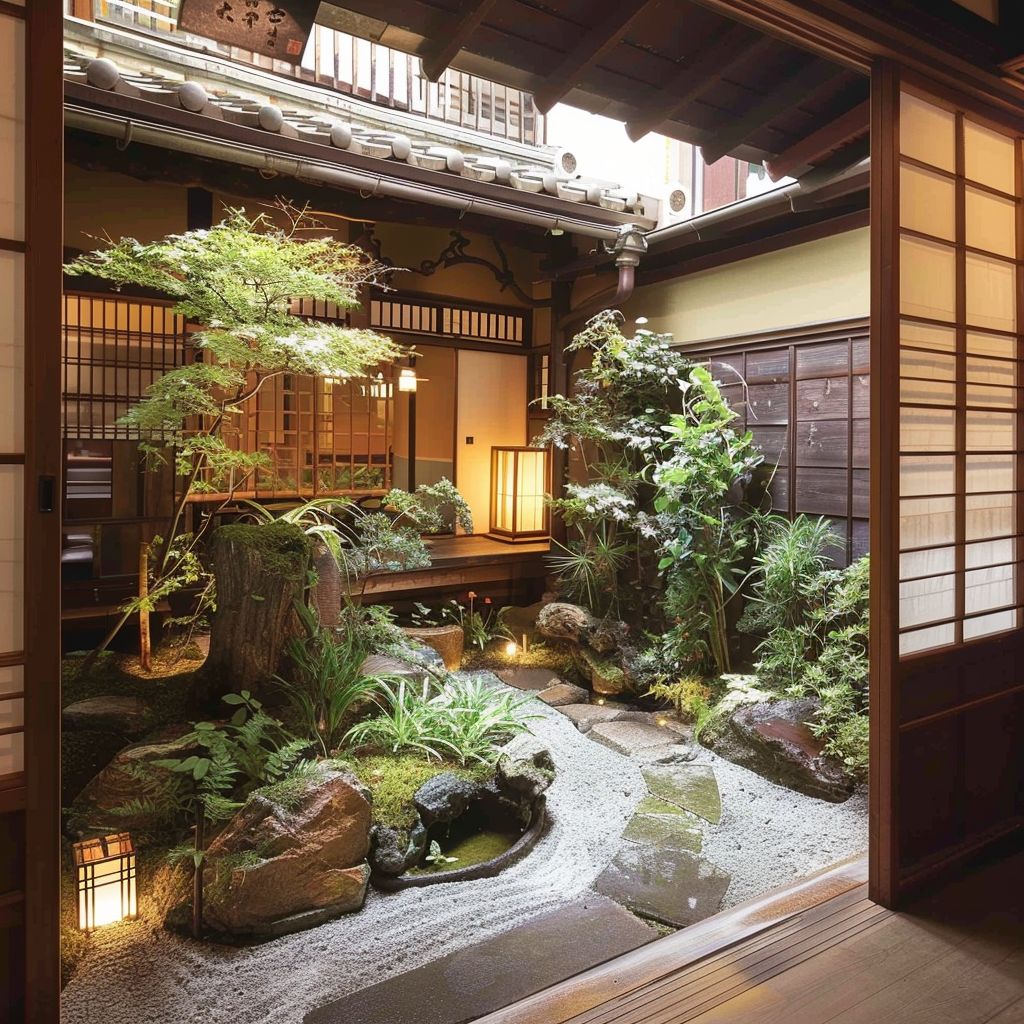
Courtyard gardens, or Tsuboniwa, are small gardens in enclosed spaces, often surrounded by walls. Typically, they combine flat stones, water features, and plants, creating a peaceful nook within the confines of a home or structure.
Borrowed Scenery (Shakkei)
Borrowed scenery, or Shakkei, involves integrating the surrounding landscape into the garden design. This technique uses distant views of mountains, forests, or buildings to create a sense of greater space and depth.
Creating a Japanese Garden
Creating a Japanese garden involves harmonising natural elements to evoke tranquility. It’s essential to balance water, rocks, and greenery to achieve a serene landscape.
These gardening design tips can help you get started:
Selecting the Right Site
Choose a quiet area with existing natural features. Having some shade improves the overall aesthetic. Pay attention to the terrain to incorporate natural slopes if possible.
Planning and Design Tips
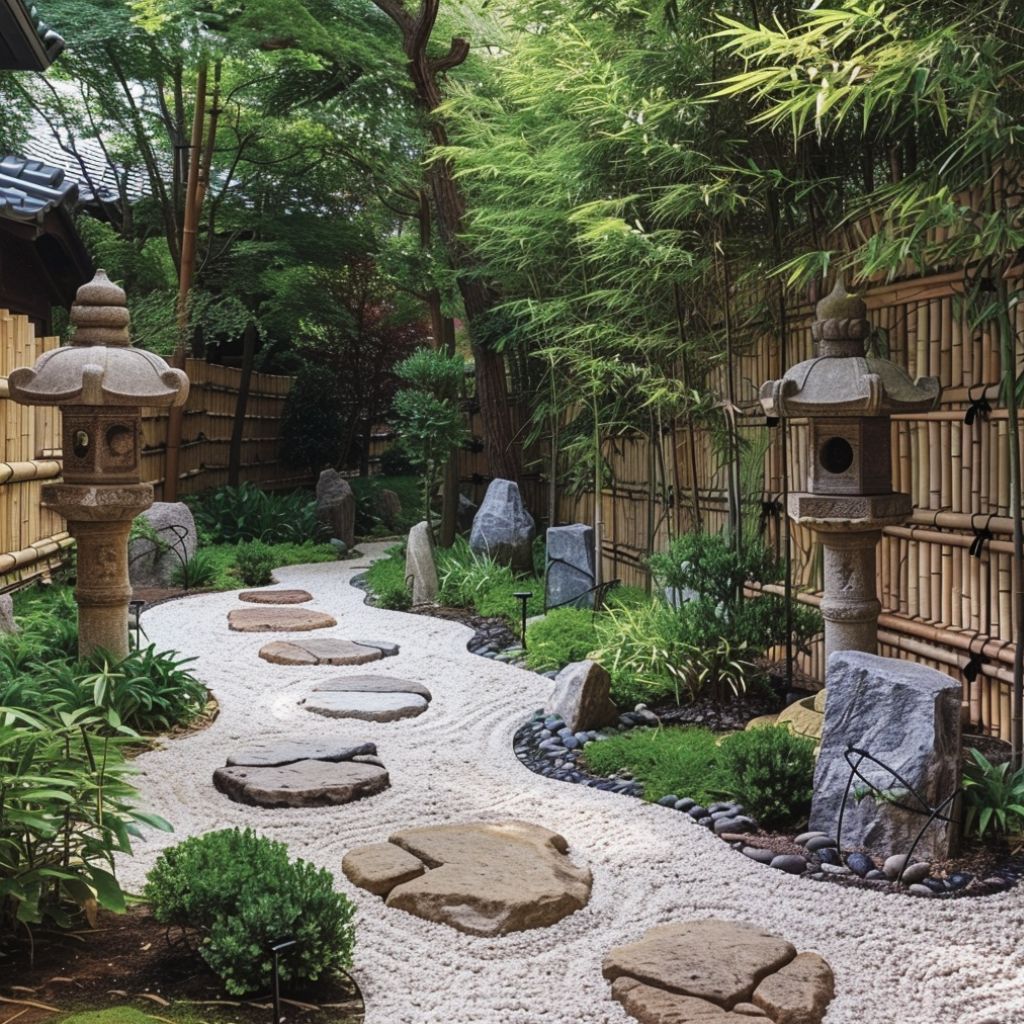
Start with a clear concept. Aim for one or two focal points like a pond or rock arrangement. Use asymmetry to create a natural feel and avoid rigid lines. Incorporate traditional elements like stone lanterns and bamboo fences sparingly for cultural touches.
Common Pitfalls to Avoid
Overcrowding with excessive elements distracts from the tranquility. Maintain simplicity to highlight each feature’s beauty. Avoid the use of artificial materials which can detract from the natural essence. Stick to minimalistic and organic components.
Maintenance and Care
Japanese gardens, known for their serene beauty, require dedicated attention to maintain their elegance.
Pruning and Plant Care
Regular pruning keeps your plants healthy and your garden looking its best. Trim shrubs into shapes or topiaries. Remove dead branches and spent flowers to promote growth. Keep creeping ground covers away from gravel areas.
Managing Water Features and Moss
Water features need routine maintenance to stay clear and functioning. Clean filters and remove debris periodically. If you have moss, encourage its growth by keeping it moist and shaded. This fosters a lush, green appearance in your garden.
Seasonal Garden Adjustments
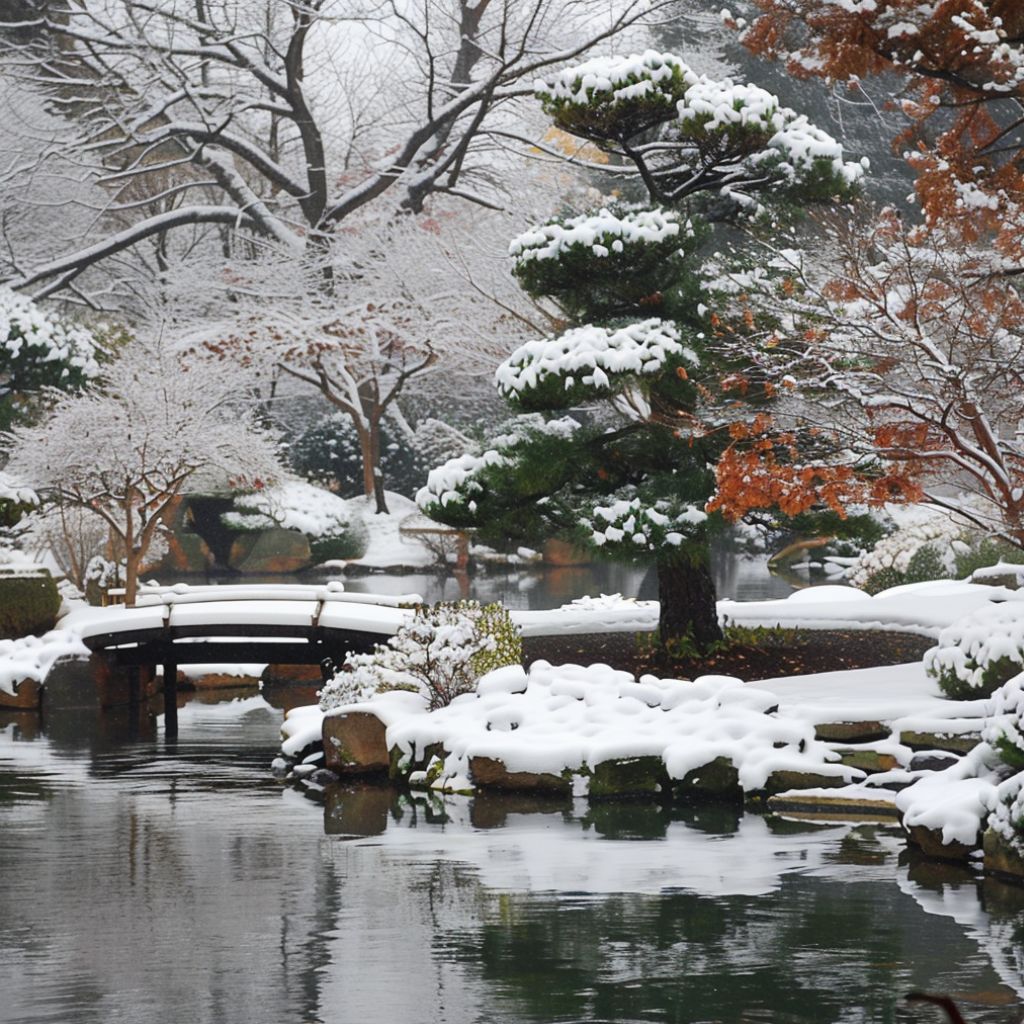
Maintenance tasks vary by season. In summer, weed control becomes more frequent. In colder months, pruning and leaf removal are more pressing. Adjust your routine to match the season’s demands, keeping your garden pristine year-round.
Up next: Start Fresh with 7 Herb Garden Ideas: The Ultimate Beginner’s Guide
